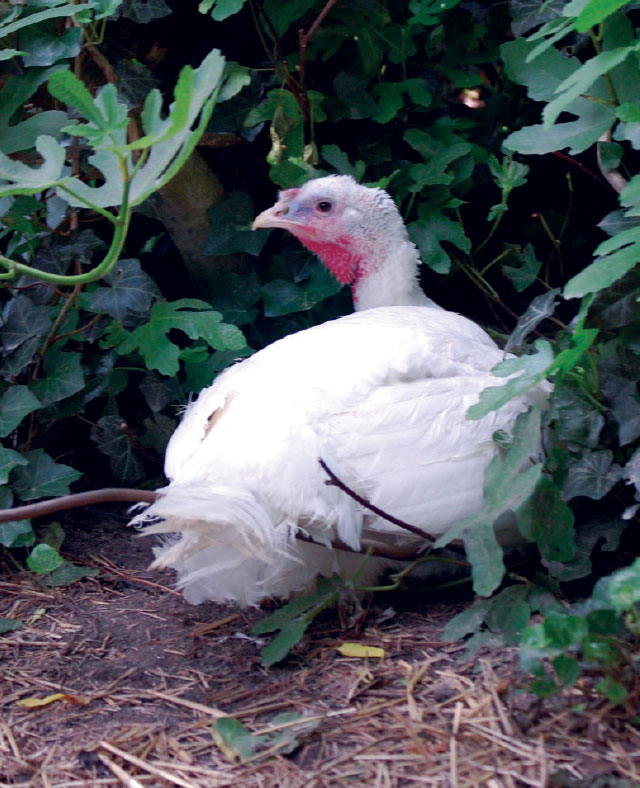Amelia, A Turkey Beloved By All

Photo: Davida G. Breier
Karen Davis's essay, distributed by the McClatchy-Tribune News Service, appeared in many newspapers at Thanksgiving, prompting kind words from people around the country.
We adopted Amelia as a young turkey in the fall of 2007 after a local farmer gave her up. She lived in our sanctuary until August this year when her legs gave out and we had to call our veterinarian, a very kind man, to put her to rest in the yard surrounded by her friends. Until those last sad days she hung out with the chickens and ducks, sat with them under the trees in the afternoon, and when people visited she’d fan out her snow white tail feathers, just like a male turkey, and stroll with the visitors, never leaving their side.
She chose a leafy nesting spot which she hollowed out a little to lay her eggs in. In the evening she loved to stay outside with the ducks, poking around until the last minute of sinking sunlight, but when I called her, “Come on, Amelia, time for bed,” she would amble into her house with the ducks to join the chickens, already perched for the night.
In her first year of life, Amelia slept on a low perch in the bird house or sat on a straw bale we kept for her there. But soon she was so heavy it was hard for her to make even a low leap, so she nestled in a corner next to the ducks, but this wasn’t her first choice. If turkeys and chickens can perch high off the ground after dark, they will.
Over the years I’ve watched many young turkeys and chickens, with their oversized breasts bred pendulously heavy for the meat industry, try to calculate a leap precisely onto a perch, a straw bale or a sawhorse. They will test the spring from the ground before making it, as if reliving an experience built into their bones and brain cells. I’ve watched them revise their position, test it again, and quit if they perceive it’s no go, with a show of disappointment and frustration, often circling the area with their necks craned before giving up entirely.
In America as late as the 1930s, turkeys were often still being driven on foot from farms to towns and cities, anywhere from 50 to 200 miles, through terrain ranging from densely wooded mountain trails to treeless Texas plains. The birds’ amiability, vigorous constitution, and long, strong legs made these drives to distant locations possible. A point made about the drives was that if the birds were not successfully regrouped each morning, they scattered in the woods and fields and could not be recovered. In addition, the birds’ determination to roost every night in the trees had to be accommodated.
In 1907 a New Hampshire historian named E. Gilbert described how during the long drives, the whole turkey flock with one accord, “rose from the road and sought a perch in the neighboring trees” at dusk. More recently, biologist William Healy noted that the determination of turkeys to perch for the night was so strong at his research station that he and his colleagues could not keep them out of the treetops even by clipping their flight feathers. “The turkeys would climb leaning branches and leap from limb to limb to get into tree crowns and then gradually work their way to the top,” he wrote.
Sanctuary workers like myself who’ve spent years in the company of turkeys and chickens bred for the meat industry know that these birds have not lost their ancestral desire to perch, mate, run, walk and be sociable. We know that the inability of turkeys to mate properly does not reflect a loss of desire to do so, but, as we see from watching them, it results from growth disorders often abetted by the fact that their claws and part of their beaks were cut off at the hatchery, so they can’t get a grip on anything. And like our Amelia, they frequently suffer from painful degenerative joint diseases that reduce their spontaneous activity and age them well before their natural 20-year lifespan.
Despite all these things, sanctuary turkeys are a joy to have around. Visitors unfamiliar with turkeys are delighted and quite taken aback at how friendly they are. Naturalist Joe Hutto has described how a group of young turkeys he was raising, upon seeing him, would drop from their roosts where they'd sat "softly chattering" and do what he calls "their joyful, happy dance, expressing an exuberance." This exuberance is an element of the life that we share with our feathered friends, and we can best give thanks by letting them live to enjoy it.